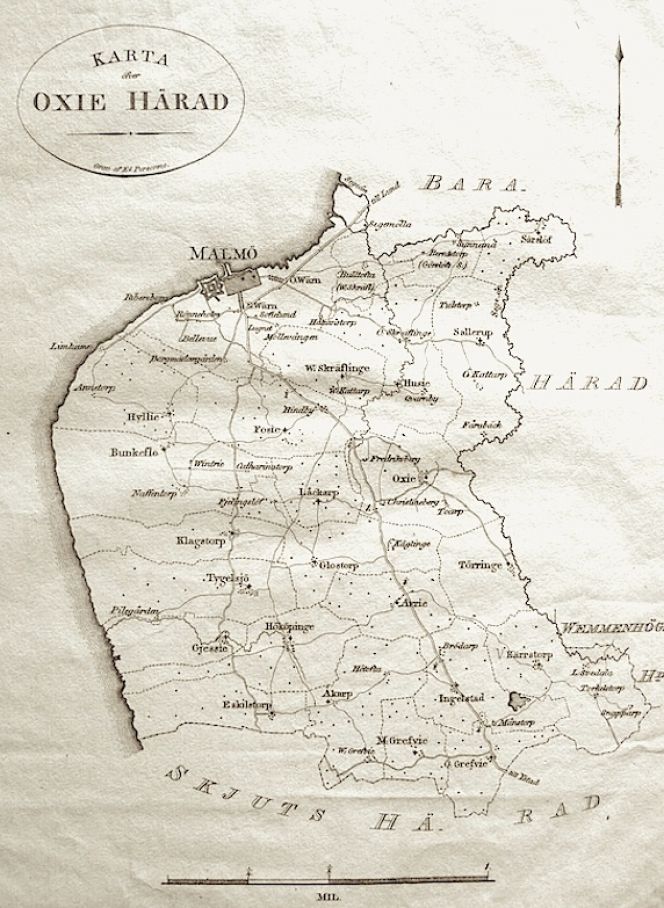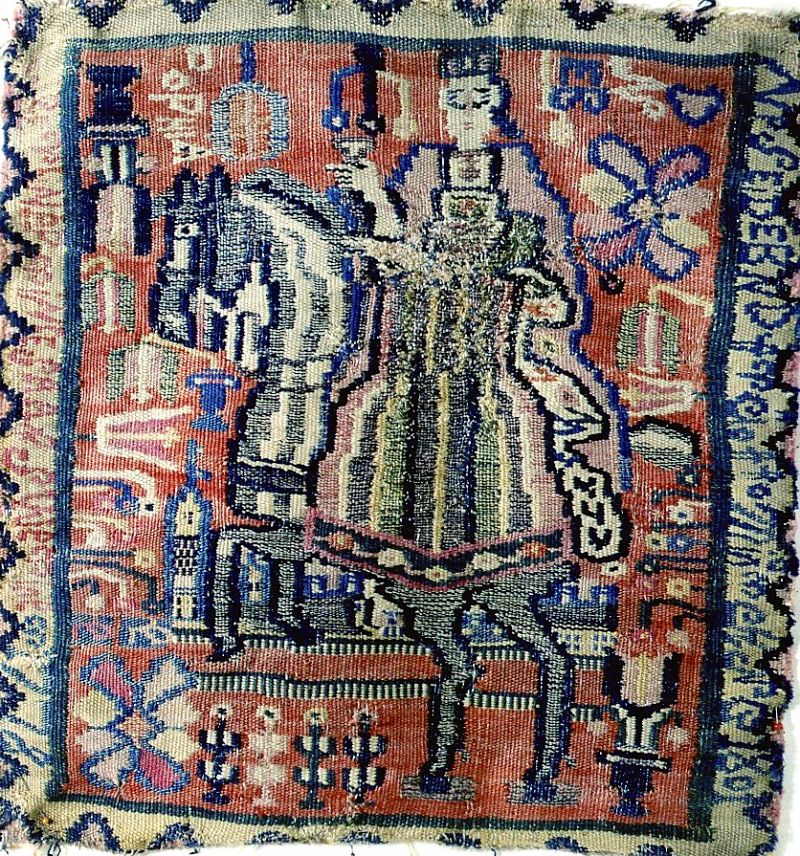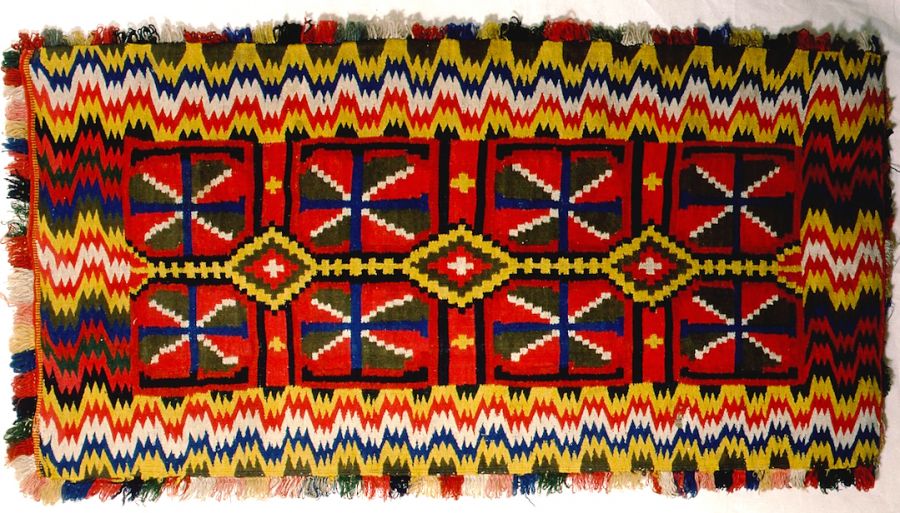ikfoundation.org
The IK Foundation
Promoting Natural & Cultural History
Since 1988


18TH- & 19TH CENTURY TEXTILES
– listed in Estate Inventories
Textiles woven in double interlocked tapestry are some of the many household items mentioned in southern Swedish estate inventories during the period from 1700 to 1850. These records are important complementary sources for the studies of the farmers’ homes’ furnishing textiles, among many other aspects of the individual family’s conditions and financial circumstances. A large number of said inventories were studied to be able to give a conclusion for the recorded textiles of this type; based on the extent of the possessions, position of the owners, the fabrics value etc and at the same time compare with other relevant source material. This essay aims to give an in-depth study of double interlocked tapestries from the Oxie district close to Malmö in Skåne.
 Undated map – probably first half of the 19th century – depicting Oxie district in southernmost Sweden. (Owner: private). Photo: The IK Foundation, London.
Undated map – probably first half of the 19th century – depicting Oxie district in southernmost Sweden. (Owner: private). Photo: The IK Foundation, London.From several districts in the county of Skåne, the estate inventories include few details about weaving techniques, but the Oxie district is one of the exceptions where considerable numbers of “rölakan” or double interlocked tapestries are listed together with other textiles from the country homes. The recorders were especially assiduous when it came to the more valuable textiles, such as various tapestry techniques and embroidered furnishing textiles. However, one must take into account that the recordings from the estate of a deceased person have great variations over time. In the early 18th century, large numbers of cushions were listed, but rarely were there any notes of technique or any other details. During the 1740s, a sudden change took place when double-interlocked tapestries started to be listed in many homes. While the records from the early 19th century and onwards are gradually simplified and reveal fewer details about singular objects, sometimes each home’s cushions and covers are only listed as a lump sum. These circumstances particularly affected the period 1820-40, when the lack of mentioned textiles primarily depended on changing manners in the description of the homes’ assets in the estate inventories. These realities can, of course, give a somewhat misrepresented picture of various weaving techniques’ occurrence during these decades. However, the list below of the study from Oxie district still gives an indication of the rise, peak, and decline in popularity of this sort of textile.
![Travel and bench cushions listed in an estate inventory in Oxie district after Anna Andersdotter in Staffanstorp dating 1785, which register a number of double interlocked tapestries described as ‘Röd lakan’. This particular year the ownership of furnishing textiles in mentioned technique reached its peak in Oxie district, as concluded from the studies of the estate inventories. (Owner: Landsarkivet [Regional State archive] Lund, Sweden). Photo: The IK Foundation, London.](https://www.ikfoundation.org/uploads/image/2-estate-inventories-jpg-664x1196.jpg) Travel and bench cushions listed in an estate inventory in Oxie district after Anna Andersdotter in Staffanstorp dating 1785, which register a number of double interlocked tapestries described as ‘Röd lakan’. This particular year the ownership of furnishing textiles in mentioned technique reached its peak in Oxie district, as concluded from the studies of the estate inventories. (Owner: Landsarkivet [Regional State archive] Lund, Sweden). Photo: The IK Foundation, London.
Travel and bench cushions listed in an estate inventory in Oxie district after Anna Andersdotter in Staffanstorp dating 1785, which register a number of double interlocked tapestries described as ‘Röd lakan’. This particular year the ownership of furnishing textiles in mentioned technique reached its peak in Oxie district, as concluded from the studies of the estate inventories. (Owner: Landsarkivet [Regional State archive] Lund, Sweden). Photo: The IK Foundation, London.Here follows an extract of the studied periods, covering ‘rölakan’ or ‘röd lakan’ (double interlocked tapestry) from the estate inventories in the Oxie district, added with the number of textiles mentioned during each year/period.
YEARS / NUMBER OF TEXTILES
- 1700-10 / 8
- 1718-20 / 0
- 1730 / 1
- 1740 / 33
- 1751 / 34
- 1760 / 57
- 1770 / 56
- 1780 / 82
- 1785 / 137
- 1790 / 86
- 1795 / 40
- 1800 / 30
- 1810 / 28
- 1820 / 1
- 1830 / 1
- 1840 / 0
 The most complicated marking found from Oxie district was placed on this unique cushion depicting a lady on horseback, including a long line of disconnected capital letters together with ‘KNB 1801’. The next sentence reads ‘Albertina Sofia prinsessa af Sverige’ (Albertina Sofia princess of Sweden) and the letters ‘DNEB’. If this woven seat cushion was intended as a gift for the person in question, or if the lady only was meant to depict Sofia Albertina is unknown. Otherwise the marking on the cushion corresponds well with her years of life (1753-1829) and the year 1801 is also within the period when double interlocked tapestries still were registered quite frequently in the estate inventories.(Owner: Malmö Museums no. 29.423). Photo: The IK Foundation, London.
The most complicated marking found from Oxie district was placed on this unique cushion depicting a lady on horseback, including a long line of disconnected capital letters together with ‘KNB 1801’. The next sentence reads ‘Albertina Sofia prinsessa af Sverige’ (Albertina Sofia princess of Sweden) and the letters ‘DNEB’. If this woven seat cushion was intended as a gift for the person in question, or if the lady only was meant to depict Sofia Albertina is unknown. Otherwise the marking on the cushion corresponds well with her years of life (1753-1829) and the year 1801 is also within the period when double interlocked tapestries still were registered quite frequently in the estate inventories.(Owner: Malmö Museums no. 29.423). Photo: The IK Foundation, London.Preserved woven textiles of known origin with markings including the year are especially significant to study jointly with the estate inventories. Signing of all kinds seems to be particularly common on decorative textiles from the Oxie district, which most probably was inspired by the area’s rich tradition of embroidered cushions, often marked with initials and year. Also, on the double interlocked tapestries, embroidered markings were sometimes added after the completion of the weaving. Still, usually initials, names or years were woven into suitable places together with the patterns during the weaving process.
![Estate inventory dating 1817 from Hans Bergquist, Walleberga, Oxie district. Among the interior decorations, two double interlocked tapestry textiles are listed as ‘Rölakans åke dyna’ and ‘Rölakans Gynne’ (travel- and seat cushion). This was a time when it had become unusual to describe the individual textiles in such detail. (Owner: Landsarkivet [Regional State archive] Lund, Sweden). Photo: The IK Foundation, London.](https://www.ikfoundation.org/uploads/image/4-estate-inventories-jpg-900x395.jpg) Estate inventory dating 1817 from Hans Bergquist, Walleberga, Oxie district. Among the interior decorations, two double interlocked tapestry textiles are listed as ‘Rölakans åke dyna’ and ‘Rölakans Gynne’ (travel- and seat cushion). This was a time when it had become unusual to describe the individual textiles in such detail. (Owner: Landsarkivet [Regional State archive] Lund, Sweden). Photo: The IK Foundation, London.
Estate inventory dating 1817 from Hans Bergquist, Walleberga, Oxie district. Among the interior decorations, two double interlocked tapestry textiles are listed as ‘Rölakans åke dyna’ and ‘Rölakans Gynne’ (travel- and seat cushion). This was a time when it had become unusual to describe the individual textiles in such detail. (Owner: Landsarkivet [Regional State archive] Lund, Sweden). Photo: The IK Foundation, London.In addition, it is possible to conclude from the estate inventories that it was the wealthier farmers, rich in possessions, who owned double interlocked tapestries. The textile belongings were here usually extensive and divided into several headings: bedclothes, bed linen, bench covers, travel cushions and clothing. However, the less wealthy families and even the poor sometimes had more textiles than expected, most often divided into bedclothes and clothing (but usually, there were never made estate inventories for the poor). The differences were foremost in that striped cushions and feather beds were owned by most people. At the same time, the more prosperous homes also included large amounts of bed linen, table linen, extra clothing, and decorative textiles. The common characteristic of the “textile abundance” was its higher value as well as economical as from a status point of view.
 This travel cushion from the south west area of Skåne is exceptionally well preserved in its colours. The textile is undated, but probably woven during the period 1770-1820. (Owner: Malmö Museums no. 443). Photo: The IK Foundation, London.
This travel cushion from the south west area of Skåne is exceptionally well preserved in its colours. The textile is undated, but probably woven during the period 1770-1820. (Owner: Malmö Museums no. 443). Photo: The IK Foundation, London.Sources:
- Hansen, Viveka, ‘Rölakan i Oxie härad’, Elbogen pp. 98-117, 1991.
- Hansen, Viveka, Textila Kuber och Blixtar – Rölakanets Konst och Kulturhistoria, Christinehof 1992 (pp. 192-99).
- Landsarkivet [Regional State archive] Lund, Sweden (18th & 19th century Estate inventories).
Essays
The iTEXTILIS is a division of The IK Workshop Society – a global and unique forum for all those interested in Natural & Cultural History from a textile Perspective.
Open Access essays, licensed under Creative Commons and freely accessible, by Textile historian Viveka Hansen, aim to integrate her current research, printed monographs, and earlier projects dating back to the late 1980s. Some essays feature rare archive material originally published in other languages, now available in English for the first time, revealing aspects of history that were previously little known outside northern European countries. Her work also explores various topics, including the textile trade, material culture, cloth manufacturing, fashion, natural dyeing, and the intriguing world of early travelling naturalists – such as the "Linnaean network" – viewed through a global historical lens.
For regular updates and to fully utilise iTEXTILIS' features, we recommend subscribing to our newsletter, iMESSENGER.
been copied to your clipboard




– a truly European organisation since 1988
Legal issues | Forget me | and much more...
You are welcome to use the information and knowledge from
The IK Workshop Society, as long as you follow a few simple rules.
LEARN MORE & I AGREE







